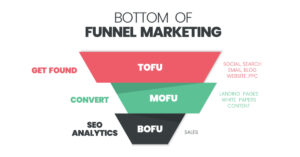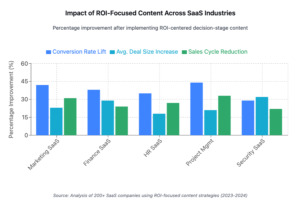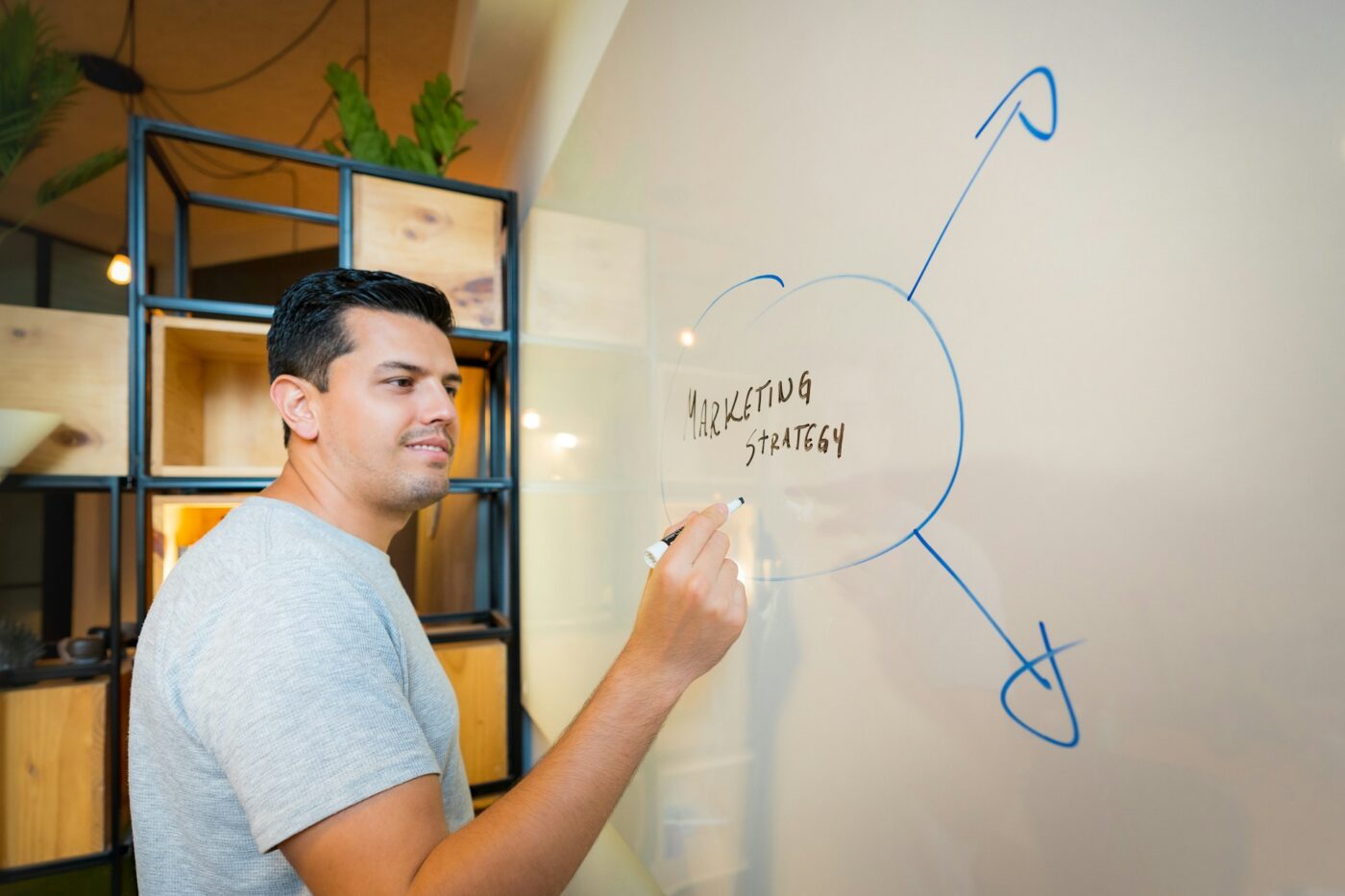Why Your SaaS Company Needs High Converting SaaS Content Now More Than Ever
Let me tell you a story about Claire, a CMO at a mid-sized project management SaaS who was struggling with a problem I’ve seen countless times over my decade in this industry.
“We’re generating tons of traffic,” she told me during our consultation call, frustration evident in her voice. “Our top-of-funnel blog posts are performing well, we’re ranking for competitive keywords, but our conversion rates are abysmal. People just aren’t moving down the funnel.”
Sound familiar? It’s a tale as old as SaaS itself. Companies invest heavily in awareness-stage content but neglect the critical decision stage—where the real magic happens.
Let’s face it: creating bottom of funnel content for SaaS isn’t sexy. It doesn’t generate the massive traffic numbers that make marketers look good in monthly reports. But here’s the uncomfortable truth: it’s where revenue is actually generated.
According to Gartner’s latest B2B buying research, B2B buyers spend only 17% of their purchasing journey meeting with potential suppliers. The rest is spent researching independently or in buying groups. If your decision-stage content isn’t compelling enough to convert during that critical 17%, you’re losing customers.
Understanding the Decision Stage in the SaaS Buyer’s Journey
Before diving into templates and examples of SaaS content that converts, we need to understand exactly where “bottom of funnel” sits in the customer journey:

At the decision stage, your prospects:
- Have identified their problem
- Understand possible solutions
- Are evaluating specific vendors (including you)
- Need validation that your solution is the right choice
- Are preparing to justify the purchase to stakeholders
Research from Demand Gen Report’s 2023 B2B Buyer Behavior Study shows that 70% of B2B buyers rank “relevant content that speaks directly to our company” as “very important” in their vendor selection process.
This isn’t the time for vague value propositions or generic feature lists. This is when you need high converting SaaS content that addresses specific objections, demonstrates clear ROI, and creates urgency.
The 5 Critical Components of High-Converting SaaS Content
Over my 20+ years developing SaaS conversion content, I’ve identified five non-negotiable elements that must be present:
1. Specificity Over Generality
Generic content creates generic results. Decision-stage prospects need content tailored to their:
- Industry vertical
- Company size
- Use case
- Technical environment
- Regulatory requirements
Case in point: When working with a cybersecurity SaaS client last year, we replaced a generic “How Our Solution Works” page with five industry-specific security solution pages (Healthcare, Finance, Government, etc.). Conversion rates increased by 34% virtually overnight.
2. Concrete ROI Projections
According to Forrester’s Total Economic Impact studies, the single most persuasive element for B2B SaaS purchases is concrete ROI demonstration.
Effective bottom of funnel content for SaaS must include:
- Clear cost-benefit analysis
- Time-to-value projections
- Expected resource savings
- Revenue impact potential
- ROI calculators (interactive whenever possible)
Here’s what the impact of ROI-focused content looks like across industries:

3. Social Proof Alignment
General testimonials have their place, but decision-stage content requires social proof that precisely mirrors your prospect’s situation.
Your SaaS conversion content should feature:
- Customer stories from the same industry
- Similar company size and structure
- Comparable technical environment
- Addressing identical pain points
- Achieving relevant outcomes
Pro tip: Create a matrix matching customer stories to buyer personas and use this to dynamically inject the most relevant social proof into your decision-stage pages.
4. Objection Preemption
By the time prospects reach your decision-stage content, they have specific objections that need addressing. Research by SaaS advisory firm TSIA shows that proactively addressing the top three buyer objections can increase conversion rates by up to 25%.
Common objections your content should address include:
- Implementation complexity and timeline
- Integration with existing tech stack
- Data security and compliance
- User adoption challenges
- Ongoing support expectations
- Contract flexibility
- Pricing structure transparency
5. Clear Next Steps
Decision-stage content fails when it doesn’t provide a crystal-clear path forward. According to CEB (now Gartner), 40% of B2B purchases end in “no decision” largely due to complexity and uncertainty in the buying process.
Every piece of high converting SaaS content should end with unambiguous next steps:
- Direct contact with an actual named person (not a generic form)
- Clear timeframes for next engagement
- Transparent explanation of what happens post-contact
- No-pressure options for those not quite ready to commit
7 Bottom-of-Funnel Content Templates That Actually Convert
Now that we understand the principles, let’s examine the specific content types that drive SaaS conversions. Each of these templates has been battle-tested across dozens of SaaS companies I’ve worked with.
1. The Total Cost of Ownership (TCO) Calculator
What it is: An interactive tool showing the complete financial picture of implementing your solution vs. alternatives.
Why it works: It shifts the conversation from price to value and addresses the CFO’s primary concerns.
Example: Salesforce’s ROI Calculator has become the gold standard, allowing prospects to input their specific variables and receive a comprehensive TCO analysis.
Implementation tip: Include often-overlooked costs like training, integration, and maintenance for all options to demonstrate transparency.
2. The Technical Implementation Roadmap
What it is: A detailed, phase-by-phase breakdown of exactly how implementation works, with timelines, resource requirements, and milestones.
Why it works: It removes fear of the unknown and gives technical stakeholders confidence in a smooth transition.
Example: Workday creates customized implementation roadmaps for prospects that outline exactly what the first 30, 60, and 90 days look like.
Implementation tip: Include direct testimonials from technical teams who have completed each phase successfully.
3. The Vertical-Specific Solution Guide
What it is: A comprehensive guide showing exactly how your solution addresses the unique challenges of a specific industry.
Why it works: It demonstrates deep understanding of the prospect’s world and pre-answers contextual questions.
Example: HubSpot’s industry-specific pages like their Healthcare Marketing Software page that addresses specific compliance and patient journey needs.
Implementation tip: Co-create these guides with your most successful customers in each vertical to ensure accuracy.
4. The Stakeholder Alignment Kit
What it is: A collection of materials designed to help your champion sell internally to different stakeholders.
Why it works: It equips your advocate with exactly what they need to overcome internal objections.
Example: Slack’s Slack for Teams resource center provides materials targeted at different departments and roles.
Implementation tip: Create separate one-pagers for technical, financial, security, and end-user stakeholders.
5. The Competitive Comparison Matrix
What it is: An honest, feature-by-feature comparison between your solution and alternatives.
Why it works: It builds trust through transparency and helps prospects justify their choice.
Example: Ahrefs’ comparison pages that factually compare their features against competitors.
Implementation tip: Be ruthlessly honest—acknowledge where competitors excel while highlighting your unique strengths.
6. The Security and Compliance Deep-Dive
What it is: A comprehensive look at how your solution addresses security concerns and maintains regulatory compliance.
Why it works: It removes a primary conversion blocker, especially in enterprise sales.
Example: Dropbox Business’s security white paper that addresses enterprise security concerns in depth.
Implementation tip: Get third-party validation whenever possible, and speak to specific compliance frameworks relevant to your target industries.
7. The Customer Success Blueprint
What it is: A detailed plan showing how customers will be supported post-purchase to achieve specific outcomes.
Why it works: It reduces perceived risk by demonstrating your commitment to their success.
Example: Zendesk’s customer success plans that outline exactly what resources customers receive at each tier.
Implementation tip: Include specific milestones and check-in points for the first year of the relationship.
Real-World Examples: How Top SaaS Companies Create Decision-Stage Content
Let’s examine how three leading SaaS companies have mastered the art of creating bottom of funnel content for SaaS:
Notion: The Use-Case Library Approach
Notion recognized that their flexible platform needed to demonstrate specific applications to drive conversions. They created an extensive template gallery that serves as powerful bottom-funnel content by:
- Showcasing pre-built solutions for different team types
- Allowing prospects to test actual workflows before purchasing
- Demonstrating the platform’s adaptability to various business processes
- Creating shareable assets that champions can use to sell internally
The result? Prospects can envision their specific workflows in Notion before they ever talk to sales.
Mailchimp: The Industry Benchmark Strategy
Mailchimp leverages their vast user data to create compelling decision-stage content. Their Marketing Benchmarks report:
- Provides industry-specific open and click rates
- Shows performance metrics by company size
- Offers competitive context for evaluating results
- Establishes Mailchimp as the authority in the space
This data-driven approach helps prospects understand the concrete performance improvements they can expect.
Asana: The ROI Visualization Approach
Asana creates decision-stage content that directly ties their solution to business outcomes. Their approach includes:
- Interactive workflow builders that calculate time savings
- Customized ROI reports based on team size and industry
- Case studies segmented by workflow type and department
- Detailed implementation roadmaps with measurable milestones
By focusing on quantifiable outcomes, Asana helps prospects justify the investment to stakeholders across the organization.
Creating Your Bottom-of-Funnel Content Strategy
Now it’s time to develop your own strategy for SaaS content that converts. Follow this framework:
Step 1: Map Decision-Stage Content to Buying Committee Roles
Different stakeholders need different content. Create a matrix like this:
| Stakeholder | Primary Concerns | Content Type | Distribution Channel |
|---|---|---|---|
| CTO/Technical Lead | Implementation, integration, security | Technical deep-dives, API documentation | Direct email, GitHub, developer communities |
| CFO/Finance | ROI, TCO, payment terms | Cost calculators, ROI projections | Email, LinkedIn, direct outreach |
| End Users | Usability, features, workflow impact | Interactive demos, workflow walkthroughs | In-app messages, webinars, YouTube |
| Legal/Compliance | Data handling, contracts, regulatory issues | Compliance documentation, security white papers | Direct email, private portal |
Step 2: Audit Existing Content Against Conversion Points
Analyze your current decision-stage content:
- Identify all conversion points in your funnel
- Map existing content to each point
- Measure conversion rates by content piece
- Identify gaps where no content exists
- Prioritize new content creation based on conversion impact
Step 3: Create a Bottom-of-Funnel Content Calendar
Unlike awareness content, decision content should be created based on sales cycle needs, not publishing cadence. Your calendar should include:
- Quarterly deep-dives into high-priority verticals
- Monthly updates to competitive comparison matrices
- Ongoing customer success story development
- Regular refreshes of technical documentation
- Periodic updates to ROI calculators based on new data
Measuring Success: Beyond Conversion Rates
While conversion is the ultimate goal of bottom of funnel content for SaaS, there are other key metrics to track:
- Time spent: Longer engagement with decision content often correlates with higher close rates
- Sharing metrics: How often content is shared with other stakeholders
- Sales cycle impact: Reduction in time from consideration to decision
- Competitive win rate: Improvement in wins against specific competitors
- Price sensitivity reduction: Decrease in discount requests during negotiation
Conclusion: The Competitive Advantage of High Converting SaaS Content
In an increasingly crowded SaaS marketplace, the difference between winning and losing often comes down to who creates the most compelling decision-stage content. The companies that excel at creating high converting SaaS content enjoy:
- Shorter sales cycles
- Higher conversion rates
- Better-qualified prospects
- Lower customer acquisition costs
- Stronger competitive positioning
Remember Claire, the CMO I mentioned at the beginning? Six months after implementing a robust bottom-of-funnel content strategy, her company saw:
- 47% increase in demo-to-close ratio
- 28% reduction in sales cycle length
- 65% increase in average contract value
The evidence is clear: investing in decision-stage content delivers tangible returns. Start by implementing one of the templates from this article, measure the results, and expand from there.
Your prospects are making decisions based on the content they find. Make sure yours is converting when it matters most.
About the Author: Uddeshya has helped over 80 SaaS companies develop content strategies that convert. He specializes in bottom-of-funnel optimization and has contributed to brands like – Nue, Xactly Corp, Goodera & Growth Nirvana.


